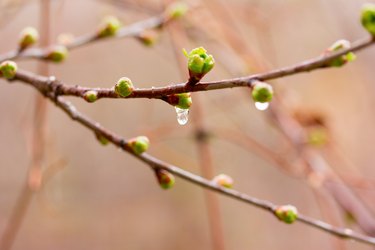
Horticulturalists, botanists and gardeners propagate certain plant species through budding, or methods of grafting in which vegetative buds of one plant are attached to another plant, known as rootstock. Budding, also known as bud grafting, is often employed in nurseries and greenhouses, though amateurs can do it themselves with a bit of practice. Budding can be used to combine cultivars from compatible species or create a clone of a single species. Fruit and nut trees are just a couple of the plants used for budding.
Common Budding Techniques
Video of the Day
Major budding techniques include T budding, in which a "t" shape is cut into the rootstock and the bud from another plant is inserted into the cut, advises West Virginia University Extension Service. T budding requires bark to be slippery enough to create a t-shaped flap, into which a smaller stick containing vegetative buds can be affixed with rubber bands or cloth then covered in plastic.
Video of the Day
In chip budding, a flat chip of bud is tied over a sliced portion of rootstock. It is preferable for thick or nonslippery bark.
Patch budding requires a piece of bark on a rootstock plant to be replaced by a bud-containing piece of bark from another plant. A rectangular slice of bark is cut from the rootstock and a similar-sized and shaped piece of bark from another plant is removed. The open pieces are put together and wrapped securely with plastic nursery tape.
Shade Trees for Budding
Deciduous shade trees are common plants used for budding to propagate nursery stock. Shade trees for budding share common characteristics, including good growth habit, disease resistance, ease of propagation and vigor. Some of the trees used in budding include the ash, birch, black gum, buckeye, dogwood, elm, gingko, hawthorn, golden chain tree, linden, locust, magnolia, maple, mountain ash, oak, redbud and sweetgum. Most shade trees propagate best using T budding.
Budding Fruit Trees
Fruit trees are often used for budding, usually using the chip or T budding method. The best time to bud fruit trees is during the summer when their buds are well developed and bark is slippery. Buds are mature enough for bud grafting when they have a brown hue.
Fruit trees are usually budded to propagate stock, though the technique can also be used to graft top branches. Common varieties include stone fruits, such as apples and crabapples, peaches and pears, advises North Carolina State University Cooperative Extension. Other commonly budded fruit trees include apricots, avocado, cherries, hackberry, kiwi, mango, mulberry, pawpaw, persimmons, plums and quince.
Nut Trees for Budding
Some nut trees propagate well when budded. Many of these trees have thin bark that responds well to chip budding, though species with especially thick bark, such as the walnut, often respond better to T budding. This can be done starting in April and then continuously throughout the growing season, or as long as mature buds are available. Nut trees for budding include the almond, chestnut, hazelnut, macadamia, pecan, pistachio and walnut.
Shrub Plants Used for Budding
A few shrub types can be propagated through budding techniques. Shrubs are primarily budded using the chip method. Shrub chip budding requires a compatible plant to use as rootstock, preferably from the same genus and species, with at least a 1/2-inch-thick stem.
Buddable shrubs include evergreen species such as cotoneasters, hollies and rhododendrons. Deciduous budding shrubs include azaleas, buckeye, flowering almond, maples, roses and serviceberries.